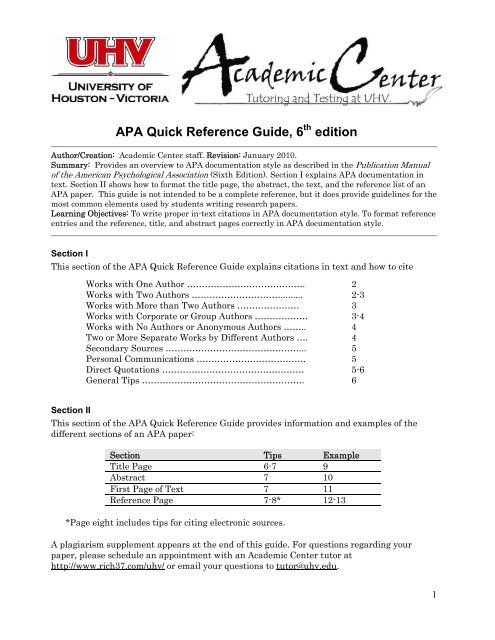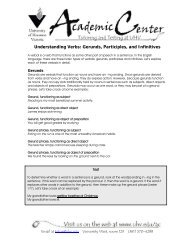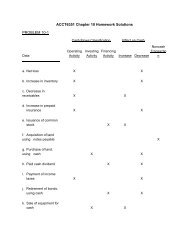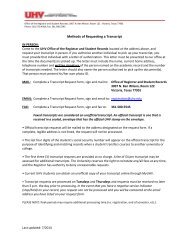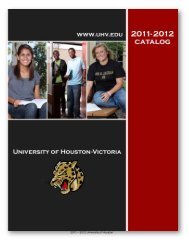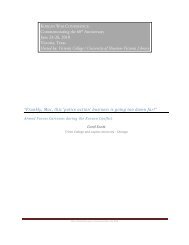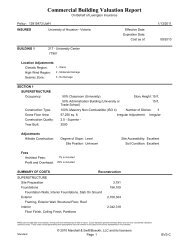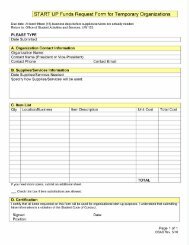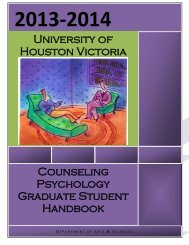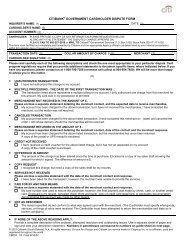APA Quick Reference Guide, 6 edition - University of Houston-Victoria
APA Quick Reference Guide, 6 edition - University of Houston-Victoria
APA Quick Reference Guide, 6 edition - University of Houston-Victoria
You also want an ePaper? Increase the reach of your titles
YUMPU automatically turns print PDFs into web optimized ePapers that Google loves.
<strong>APA</strong> <strong>Quick</strong> <strong>Reference</strong> <strong>Guide</strong>, 6 th <strong>edition</strong><br />
Author/Creation: Academic Center staff. Revision: January 2010.<br />
Summary: Provides an overview to <strong>APA</strong> documentation style as described in the Publication Manual<br />
<strong>of</strong> the American Psychological Association (Sixth Edition). Section I explains <strong>APA</strong> documentation in<br />
text. Section II shows how to format the title page, the abstract, the text, and the reference list <strong>of</strong> an<br />
<strong>APA</strong> paper. This guide is not intended to be a complete reference, but it does provide guidelines for the<br />
most common elements used by students writing research papers.<br />
Learning Objectives: To write proper in-text citations in <strong>APA</strong> documentation style. To format reference<br />
entries and the reference, title, and abstract pages correctly in <strong>APA</strong> documentation style.<br />
Section I<br />
This section <strong>of</strong> the <strong>APA</strong> <strong>Quick</strong> <strong>Reference</strong> <strong>Guide</strong> explains citations in text and how to cite<br />
Works with One Author …………………………………. 2<br />
Works with Two Authors …………………………......... 2-3<br />
Works with More than Two Authors ………………… 3<br />
Works with Corporate or Group Authors ……………… 3-4<br />
Works with No Authors or Anonymous Authors …….. 4<br />
Two or More Separate Works by Different Authors …. 4<br />
Secondary Sources ………………………………………... 5<br />
Personal Communications ………………………………. 5<br />
Direct Quotations ………………………………………… 5-6<br />
General Tips ………………………………………………. 6<br />
Section II<br />
This section <strong>of</strong> the <strong>APA</strong> <strong>Quick</strong> <strong>Reference</strong> <strong>Guide</strong> provides information and examples <strong>of</strong> the<br />
different sections <strong>of</strong> an <strong>APA</strong> paper:<br />
Section Tips Example<br />
Title Page 6-7 9<br />
Abstract 7 10<br />
First Page <strong>of</strong> Text 7 11<br />
<strong>Reference</strong> Page 7-8* 12-13<br />
*Page eight includes tips for citing electronic sources.<br />
A plagiarism supplement appears at the end <strong>of</strong> this guide. For questions regarding your<br />
paper, please schedule an appointment with an Academic Center tutor at<br />
http://www.rich37.com/uhv/ or email your questions to tutor@uhv.edu.<br />
1
<strong>APA</strong> <strong>Quick</strong> <strong>Reference</strong> <strong>Guide</strong>: Section I<br />
<strong>APA</strong> style uses the author-date method <strong>of</strong> citation: the surname <strong>of</strong> the author and the year <strong>of</strong><br />
publication are inserted in the text at a specified point. This method gives readers useful<br />
information in text and helps them locate the citation easily in the alphabetical reference list.<br />
For direct quotations, the page number must be cited as well (see page 5 <strong>of</strong> this guide for<br />
more information). Generally, the author and year should not be separated. Note: If your<br />
instructor's guidelines differ from those specified in this guide, follow your instructor's<br />
requirements.<br />
Works with One Author<br />
If the name <strong>of</strong> the author occurs in the discussion within the sentence and you are<br />
paraphrasing or summarizing the original material, cite only the year <strong>of</strong> publication in<br />
parentheses. If the sentence does not mention the author's name, cite both the author and the<br />
year in parentheses, but separate the author and year with a comma.<br />
Jackson (1996) identifies three key problems that lead to stress in today's families.<br />
or<br />
Today's families face three main problems that can cause stress (Jackson, 1996).<br />
In continuous discussion <strong>of</strong> a particular source's ideas, after the initial parenthetical citation,<br />
you can cite the author's name without the parenthetical citation <strong>of</strong> the year if no ambiguity<br />
results within that paragraph. If the reader might misinterpret the source <strong>of</strong> the information,<br />
provide the year <strong>of</strong> publication. (In an actual paper, the following text would be doublespaced.)<br />
Davidson (1996) concludes that psyche represents the source <strong>of</strong> the problem. His<br />
studies <strong>of</strong> adolescents reveal that pressures tend to arise during the early years <strong>of</strong><br />
psychological development. These pressures can include peer interactions, family<br />
obligations, and academic achievement. Davidson suggests that parents recognize the<br />
effects that these pressures can have on their teens.<br />
Note that this form can only be used if the author’s name is included as part <strong>of</strong> the narrative.<br />
If the name and year are both used in a parenthetical in the first reference, subsequent<br />
references should have the year included.<br />
Studies <strong>of</strong> adolescents reveal that pressures tend to arise during the early years <strong>of</strong><br />
psychological development (Davidson, 1996). Davidson (1996) elaborates that…<br />
Works with Two Authors<br />
If a work has two authors, always cite both authors' names every time you cite the source.<br />
(The examples in the following text would be double-spaced if they appeared in the text <strong>of</strong> an<br />
actual paper.)<br />
Braden and Darly (1997) recognize the financial benefits <strong>of</strong> this tax deduction. If<br />
individuals apply for this specific deduction by September 1, 1997, then their tax<br />
liability is decreased by $200.00. Braden and Darly suggest that qualifying individuals<br />
file at least one month in advance <strong>of</strong> the deadline.<br />
2
For parenthetical citations <strong>of</strong> two authors, use the ampersand symbol & instead <strong>of</strong> the word<br />
and. For parenthetical citations <strong>of</strong> two authors, insert a comma between the last name<br />
mentioned and the year <strong>of</strong> publication.<br />
Qualifying individuals need to file at least one month in advance (Braden & Darly,<br />
1997).<br />
Works with More than Two Authors<br />
If the work has from three to five authors, cite all the authors the first time the reference<br />
occurs. In subsequent citations <strong>of</strong> the same source, include only the surname <strong>of</strong> the first<br />
author followed by the words et al. (Do not italicize et al., but do use a period following al.)<br />
(The examples in the following text would be double-spaced if they appeared in the text <strong>of</strong> an<br />
actual paper.)<br />
Jarvis, Haley, and Reed (1996) indicate that the computer operating system is<br />
extremely efficient. The program works well with integrated packages, and it provides<br />
more user options. Jarvis et al. conclude that this operating system represents the<br />
best one on the market.<br />
For discontinuous discussion or where ambiguity may result, place the year after et al.<br />
The authors indicate that web technology enables anyone to publish: The approval or<br />
sanction <strong>of</strong> others is not needed. The effect is that writers are liberated, but readers<br />
bear the burden because they must be more critical <strong>of</strong> what they read (Jarvis et al.,<br />
1996).<br />
Be careful with citations <strong>of</strong> two sources that have the same first name and same year.<br />
Harkins, Straight, and Lemper (1996) . . .<br />
Harkins, Madison, and Levitt (1996) . . .<br />
In subsequent citations, each source above could technically be cited as "Harkins et al.<br />
(1996)" in text, making the two indistinguishable. In such cases, cite the surnames <strong>of</strong> the first<br />
authors and <strong>of</strong> as many <strong>of</strong> the subsequent authors as necessary to distinguish the two<br />
references. “(Harkins, Straight et al., 1996)” would be the correct parenthetical citation.<br />
For sources with six or more authors, always cite only the first author’s last name followed by<br />
et al. in text. (See page 175 in the <strong>APA</strong> Manual.) If you should encounter a situation where<br />
the same first few authors <strong>of</strong> two studies produced in the same year, as in the scenario above,<br />
you should follow the same guideline <strong>of</strong> including as many <strong>of</strong> the authors as necessary to<br />
distinguish the two.<br />
Note: In the reference list, a study with six to seven authors would have all authors listed.<br />
If the work has eight or more authors, list the first six authors, insert three ellipses,<br />
and the last author’s name.<br />
Works with Corporate or Group Authors<br />
When a group (e.g. corporations, associations, and government agencies) serve as the author<br />
<strong>of</strong> an article, the name <strong>of</strong> the group should be spelled out in the first reference. For most<br />
groups, an abbreviation will follow that will be used in subsequent references. To decide<br />
whether to use an abbreviation, consider whether the abbreviation form is common enough to<br />
locate the source on the reference list.<br />
3
The first time corporate or group authors are used, spell out the names followed by the<br />
abbreviated form in parentheses. (In an actual paper, the following text would be doublespaced.)<br />
The Department <strong>of</strong> Public Safety (DPS, 1997) explains that the increase in traffic<br />
problems is particular to a given location.<br />
or<br />
The increase in traffic problems is particular to a given location (Department <strong>of</strong> Public<br />
Safety [DPS], 1997).<br />
If the name <strong>of</strong> the group is short or if abbreviation is unknown or could cause ambiguity, it is<br />
better to spell out the entire group name each time it is used.<br />
Note: In the reference list, always write out the full corporate or group author name.<br />
See pages 94-95 <strong>of</strong> the <strong>APA</strong> manual for the use <strong>of</strong> brackets.<br />
Works with No Authors or Anonymous Author<br />
If a work has no author, use the first two or three words <strong>of</strong> the source's title and the year.<br />
(The examples in the following text would be double-spaced if they appeared in the text <strong>of</strong> an<br />
actual paper.)<br />
The title <strong>of</strong> an article, chapter, or webpage with no author should be enclosed in quotation<br />
marks:<br />
The juvenile detention center contains many repeat <strong>of</strong>fenders ("Juvenile Recidivism,"<br />
1997).<br />
The title <strong>of</strong> a book, periodical, brochure, or report with no author should be italicized:<br />
Most employees experience violence in the workplace at least once (Business Trends,<br />
1996).<br />
If a work indicates the author is anonymous, cite in text the word Anonymous (not italicized)<br />
followed by a comma and the date. In the reference list, alphabetize by the word Anonymous.<br />
Copyright and authority are <strong>of</strong>ten extensions <strong>of</strong> each other in the print culture<br />
(Anonymous, 2001).<br />
Note: Legal materials should be treated as a work with no author using the first few words<br />
and the year in the in-text reference. See pages 216-224 <strong>of</strong> the <strong>APA</strong> Manual for<br />
further information regarding citing specific types <strong>of</strong> legal references.<br />
Two or More Separate Works by Different Authors<br />
When citing several works by different authors within the same parentheses, list them in<br />
alphabetical (not chronological) order by the first author's surname. Separate the citations by<br />
semicolons. (In an actual paper, the following text would be double-spaced.)<br />
Several studies by environmentalists indicate that the rain forests soon will live only in<br />
our memories (Decker & Nowles, 1997; Marley, 1995; Sullivan, 1996).<br />
If one <strong>of</strong> the studies is a major citation, it can be separated from the others within the<br />
parentheses by inserting a phrase such as see also before the other citations included.<br />
(Dabney, 1936; see also Woodward, 1971; Grantham, 1983)<br />
4
Secondary Sources<br />
Secondary sources are works that reference other authors. Always try to locate and use the<br />
original work. If it is not possible to do so, cite the original source (the source who originally<br />
stated the idea) in your sentence and the secondary source (the source where you actually<br />
located the information) and its year <strong>of</strong> publication in parentheses. Include the words as cited<br />
in (not italicized) for the parenthetical documentation <strong>of</strong> the secondary source. Provide a year<br />
<strong>of</strong> publication only for the source where you located the information since only this source<br />
will be listed in your reference section. (In an actual paper, the following text would be<br />
double-spaced.)<br />
According to Sampson (1954), individuals tend to vote the party supported by their<br />
ancestors (as cited in Povarick, 1996).<br />
Note: Sampson = original person making the observation<br />
Povarick = secondary source where Sampson's observation is discussed.<br />
Personal Communications<br />
Personal communications include interviews, e-mails, electronic bulletin boards, letters,<br />
memos, and telephone conversations. Use the interviewee's initials or first name, the<br />
surname, and the exact date <strong>of</strong> the communication. Identify this source as personal<br />
communication and provide the date at the end <strong>of</strong> the first sentence referencing the source by<br />
name. Personal communications are considered non-recoverable data, which means it should<br />
not be listed in the references. (In an actual paper, the following text would be doublespaced.)<br />
Dr. J. Thompson, humanities pr<strong>of</strong>essor at Purdue, stresses the crucial feature <strong>of</strong> point<br />
<strong>of</strong> view in a piece <strong>of</strong> literature (personal communication, January 17, 1997). She<br />
emphasizes that the point <strong>of</strong> view represents a unique feature within fictional texts.<br />
Some forms <strong>of</strong> communication facilitate informality in communication; information cited<br />
should always have scholarly relevance.<br />
Direct Quotations<br />
When directly repeating words from a source, use quotation marks to indicate the original<br />
wording used by the source.<br />
When citing print sources you have quoted, include the page number in your citation.<br />
Electronic sources may or may not have page numbers. Include the page number if the<br />
electronic source does have a page number. If the electronic source does not have a page<br />
number, include paragraph numbers (if visible). If paragraph numbers or page numbers are<br />
not visible and headings are within the document, cite the heading and the number <strong>of</strong> the<br />
paragraph following the heading to direct the reader to the quoted material. Use the<br />
abbreviation “para.” When no page, or paragraph is used or if the headings are too unwieldy<br />
to cite in full, it may be necessary to use a shortened version <strong>of</strong> the title in quotation marks<br />
instead. (See page 172 in the <strong>APA</strong> Manual for further information.)<br />
Short Quotations (fewer than 40 words)<br />
Incorporate the information into the text <strong>of</strong> the sentence. Place the period after the<br />
parenthetical citation <strong>of</strong> the page number. (In an actual paper, the following text would be<br />
double-spaced.)<br />
5
Rivera (1998) found that "98% <strong>of</strong> those surveyed preferred the term 'bucket' to 'pail'"<br />
(p. 34).<br />
As Norlink (2001) indicates, “hypnosis is effective in 35 out <strong>of</strong> 100 cases” (Hypnosis<br />
Explained section, para. 3).<br />
Long Quotations (40 or more words)<br />
For long quotations, use the block quote format and omit the quotation marks (unless the<br />
author uses quoted information). Begin the quote on a new line indented ½ inch from the left<br />
margin only and type the block quotation using double spacing between the lines. Place a<br />
period at the end <strong>of</strong> the quotation, followed by a single space, and then type “p.” and the page<br />
number(s) in parentheses. (Quotation marks should not be included around p.) Note that no<br />
period follows the closing parenthesis. (In an actual paper, the following text would be<br />
double-spaced.)<br />
According to Haley (1996), the bonding process occurs within the first two weeks after<br />
birth:<br />
The bonding process among infants exhibits a unique characteristic within the 14-day<br />
post-partum period. During this time, infants can identify and later recognize<br />
characteristics unique to the caretaker. These characteristics can include the tone <strong>of</strong><br />
voice, body scent, and smile <strong>of</strong> a given caretaker. (p. 61)<br />
This bonding process, unless interrupted, can significantly affect the relationship that<br />
develops during the pre-school years.<br />
Note: For quotes from two or more pages, use "pp." and the page numbers (pp. 56-57).<br />
Note: To identify information within a block quotation that is already quoted, use double<br />
quotation marks around the quoted material.<br />
General Tips<br />
♦ Use a topic sentence to "set up" the discussion within an entire paragraph.<br />
♦ Avoid "stringing together" sources, which involves placing one author's information in<br />
one sentence and moving on to another source's information in the next. Comment on,<br />
conclude, interpret, or "tie up the loose ends" <strong>of</strong> one author's information before<br />
advancing to another source.<br />
♦ Spell out numbers zero through nine; use the Arabic representations for 10 and over.<br />
♦ Use <strong>APA</strong> preferred spelling and capitalization for common terms: database, e-mail, FTP,<br />
Internet, online, PDF, URL, and Web.<br />
<strong>APA</strong> <strong>Quick</strong> <strong>Reference</strong> <strong>Guide</strong>: Section II<br />
Section II <strong>of</strong> the <strong>Quick</strong> <strong>Reference</strong> <strong>Guide</strong> shows you about the formatting conventions <strong>of</strong> <strong>APA</strong><br />
style and also provides tips.<br />
Title Page<br />
A sample title page is shown on p. 9 <strong>of</strong> this guide. Elements <strong>of</strong> the title page will include<br />
minimally a running head, title, author’s name, and institutional affiliation. Some<br />
documents may require an author’s note. However, for most class papers, the author’s note is<br />
not required. If you do need one, see pages 24-25 in the <strong>APA</strong> Manual.<br />
6
Tips for the Title Page<br />
In the header position type a running head on the left margin. This should be titled<br />
“Running head:” and be followed by a shortened version <strong>of</strong> the title written in all capital<br />
letters, as shown on the sample page. (Quotation marks should not be included around<br />
Running head:.) The running head should not exceed 50 characters, including spaces and<br />
punctuation. On the right margin <strong>of</strong> the header include the page number; for a title page this<br />
should be 1. Center the paper’s title, your name, and the university’s name in the upper half<br />
<strong>of</strong> the page. For more information on title pages, visit pages 23 and 229 in the <strong>APA</strong> Manual.<br />
Abstract<br />
The abstract <strong>of</strong> an <strong>APA</strong> paper should follow the format shown on p. 10 <strong>of</strong> this guide. The<br />
abstract provides a brief description <strong>of</strong> the contents <strong>of</strong> your paper.<br />
Tips for the Abstract<br />
♦ The abstract should have the running head in the header position and the page number 2.<br />
Omit the words “Running head:” on all but the title page.<br />
♦ Three lines below the header type the word Abstract (without italics). Center it<br />
horizontally.<br />
♦ Double space between the word Abstract and the text.<br />
♦ Do not indent the text on this page; keep it all one unindented paragraph.<br />
Tips for Writing the Abstract<br />
♦ Write your abstract last, after you have written the paper.<br />
♦ Keep it short—150 words is about average. It should range from 150-250 words.<br />
♦ Double space your abstract and do not indent the first line <strong>of</strong> text. You should have 1<br />
paragraph with no indentation.<br />
♦ Use only your own words and do not use any outside sources. The only time that outside<br />
sources should ever be noted in an abstract is if the document replicates or expands a<br />
prior study.<br />
The exact content <strong>of</strong> the abstract may vary based on the type <strong>of</strong> study that the document<br />
provides. For a list <strong>of</strong> suggested elements see pages 26-27 <strong>of</strong> the <strong>APA</strong> Manual.<br />
First Page <strong>of</strong> Text<br />
The first page <strong>of</strong> your text should follow the format shown on page 11 <strong>of</strong> the <strong>Quick</strong> <strong>Guide</strong>.<br />
Tips for the First Page <strong>of</strong> Text<br />
♦ The running head should appear in the header position along with the number 3. Omit<br />
the words “Running head:” on all but the title page.<br />
♦ Three lines below the header type the complete title <strong>of</strong> the paper (the same title that<br />
appears on your title page). The title should be written in standard font, no italics or<br />
bolding.<br />
♦ Double space between title and text, and continue double spacing throughout the text.<br />
<strong>Reference</strong>s Page<br />
The purpose <strong>of</strong> the references page is to enable readers to retrieve and use the sources, so the<br />
information provided should be as complete and accurate as possible. Writers are responsible<br />
for the completeness and accuracy <strong>of</strong> their reference lists. Entries for sources from print<br />
media and electronic media both send readers to the source’s location, but electronic source<br />
entries <strong>of</strong>ten have more parts because they require more information to get readers to the<br />
source. A sample reference page, including sample references, can be found on pages 12-13 <strong>of</strong><br />
the <strong>Quick</strong> <strong>Guide</strong>.<br />
7
Parts <strong>of</strong> the basic print entry<br />
Author(s). (Date). Title(s). Publication data.<br />
Parts <strong>of</strong> the basic electronic entry<br />
Author(s). (Date). Title(s). Print publication data. Access data (including URL or DOI<br />
if available)<br />
For more specific information on electronic entries and guidelines on what to do if your source<br />
is different from the kind <strong>of</strong> source illustrated in the basic entry model we provided above, see<br />
pages 187-192 in the 6 th <strong>edition</strong> <strong>of</strong> the <strong>APA</strong> Manual.<br />
Note: The bold text on the sample reference page indicates the type <strong>of</strong> source referenced and<br />
should not be included in your references page.<br />
Tips for the <strong>Reference</strong> Page<br />
♦ Arrange entries in alphabetical order.<br />
♦ Maintain double spacing on the reference page, with no extra spaces between references.<br />
♦ Begin reference entries flush left. Indent the second and subsequent lines <strong>of</strong> each entry.<br />
♦ Pay special attention to <strong>APA</strong>'s conventions for capitalization.<br />
♦ Many journal articles contain a DOI which is a universal identification number. If the<br />
article, whether print or online version, has a DOI, this number should be provided in the<br />
references.<br />
Tips for Citing Electronic Sources on the <strong>Reference</strong> Page<br />
♦ Ideally, Internet entries should have an author. At the very least, Internet sources<br />
should provide a document title and description, date, and Web address.<br />
♦ Use “retrieved from” to indicate information obtained from a document on the Internet.<br />
♦ Finish the retrieval element with a period unless it ends with a Web address.<br />
8
Running head: TEACHING TECHNICAL COMMUNICATION ONLINE 1<br />
Note: The running head should appear one-half<br />
inch from the top <strong>of</strong> the page in the header<br />
position. Type the words Running head: and<br />
include a shortened version <strong>of</strong> the paper’s title.<br />
Three Types <strong>of</strong> Communication and Effective Online Teaching<br />
in the Technical Communication Field<br />
Dawn L. Summers<br />
<strong>University</strong> <strong>of</strong> <strong>Houston</strong>-<strong>Victoria</strong><br />
Note: The footer in this guide is to help you<br />
locate pages from the table <strong>of</strong> contents. You<br />
should not include a footer in your paper.<br />
9
TEACHING TECHNICAL COMMUNICATION ONLINE 2<br />
Abstract<br />
This paper introduces a new approach to the technical communication field by discussing the<br />
student-instructor, student-student, and student-content communications that must occur<br />
successfully within an online course to make it valuable to students. This approach appears <strong>of</strong>ten<br />
in discussions surrounding distance education or online teaching, but has not been directly<br />
applied to teaching technical communication online. Specifically, this paper examines five<br />
strategies for each <strong>of</strong> these communication types and draws on research in the technical<br />
communication and distance learning fields in order to <strong>of</strong>fer a mix <strong>of</strong> theory and practice, but it<br />
focuses more on successful practices so that it may be <strong>of</strong> immediate use for instructors new to<br />
teaching online. This paper defines online teaching as instruction where the instructor and<br />
student are physically separate and learning takes place primarily online (the Internet or World<br />
Wide Web). This instruction may occur either synchronously or asynchronously.<br />
Note: The footer in this guide is to help you<br />
locate pages from the table <strong>of</strong> contents. You<br />
should not include a footer in your paper.<br />
10
TEACHING TECHNICAL COMMUNICATION ONLINE 3<br />
Three Types <strong>of</strong> Communication and Effective Online Teaching<br />
in the Technical Communication Field<br />
Even a cursory search <strong>of</strong> the Internet reveals the growth <strong>of</strong> distance education, <strong>of</strong> schools<br />
reaching out to students. In the technical communication field, students can find certificate<br />
programs, bachelor and master programs available via a variety <strong>of</strong> distance means<br />
(correspondence, ITV, and partially or fully online) from a variety <strong>of</strong> different traditional and<br />
non-traditional institutions and organizations. Simply put, students have ever-increasing options<br />
for their education in technical communication. For those instructors teaching online the<br />
question then becomes, what composes a successful online course or program in technical<br />
communication? Various authors (Boyden et al., 1988; Tebeaux, 1995, and Wendel, n.d., to<br />
name a few) have begun to suggest some answers for the technical communication field.<br />
Tebeaux suggests that communication is what underlies successful online courses and programs<br />
and ultimately successful online learning experiences. Two communication themes are explicit in<br />
Tebeaux’s discussion: student-instructor (instructor becomes facilitator) and student-content<br />
(student takes an active role in acquiring knowledge). A third communication theme is more<br />
subtle in Tebeaux’s definition but is vital, namely student-student communication. This paper<br />
uses these three communication dimensions (student-instructor, student-content, and student-<br />
student) as an organizing framework in order to suggest practical strategies that a technical<br />
communication instructor would want to consider as planning or teaching an online course.<br />
Online Teaching Defined<br />
The literature surrounding online teaching uses many terms to refer to this concept. A<br />
few examples include web-based teaching, computer-based Note: The footer teaching, in this computer-assisted<br />
guide is to help you<br />
locate pages from the table <strong>of</strong> contents. You<br />
teaching, teaching in virtual classrooms, and finally, should the all-inclusive not include a distance footer in education. your paper.<br />
In this<br />
11
TEACHING TECHNICAL COMMUNICATION ONLINE 20<br />
<strong>Reference</strong>s<br />
Boyden, C. H., Apple, R., Regunote, M., Qu, S., Weston, L., Anton, R., . . . . Smith, L. (1998).<br />
The culture <strong>of</strong> distance education. Journal <strong>of</strong> Business and Technical Communication,<br />
7(3), 65-88. (Journal with discontinuous pagination; More than eight authors; No DOI provided)<br />
Ellis, R. A., Ginns, P., & Piggott, L. (2009, September). E-learning in higher education: Some<br />
key aspects and their relationship to approaches to study. Higher Education Research &<br />
Development, 28(3), 303-318. doi: 10.1080/07294360902839909 (Journal with<br />
discontinuous pagination; DOI provided)<br />
Institute on Communication. (2000). Distance education research at the Institute on<br />
Communication. (IC Publication No. 000-08-9532). Retrieved from<br />
http://www.ic.nih.gov/publication/teachingrresfact.cfm (Corporate author; Technical or<br />
research report; Published on the Internet)<br />
Jarvis, Y. R., Haley, S. T., & Reed, R. W. (1996). Active and reflective e-learning. In L. D.<br />
White (Ed.), An overview <strong>of</strong> learning online (pp. 372-401). Englewood Cliffs, NY:<br />
Prentice Hall. (Article in edited book)<br />
Pall<strong>of</strong>f, R. M., & Pratt, K. (1999). Building learning communities in cyberspace: Effective<br />
strategies for the online classroom (2nd ed.). San Francisco: Jossey-Bass.<br />
(Book)<br />
Reflective e-learning in technical writing courses. (2003, Fall). The Technical Writer<br />
Newsletter, 4, 2-3. (Newsletter article; No author)<br />
Salmon, G. (2000). E-moderating: The key to teaching and learning online. London: Kogan<br />
Page. Retrieved from http://www.netlibrary.com/Reader/ (Electronic version <strong>of</strong> print book)<br />
12
TEACHING TECHNICAL COMMUNICATION ONLINE 21<br />
Tebeaux, E. (1995). Technical writing by distance: Refocusing the pedagogy <strong>of</strong> technical<br />
communication. Technical Communication Quarterly, 4(4), 365-395. (Journal<br />
with continuous pagination)<br />
Wendel, D. W. (n.d.). Wave goodbye to mail-order courses: The digital evolution <strong>of</strong> distance<br />
education. Baltimore: John Hopkins Center for Education. (ERIC Document<br />
Reproduction Service No. ED183875) (ERIC source; No date)<br />
Note: Maintain double-spacing on the reference page, with no extra spaces between citations.<br />
Note: The bold text on the sample pages indicates the type <strong>of</strong> source being referenced. Do not include it on your<br />
references page.<br />
Note: The footer in this guide is to help you locate pages from the table <strong>of</strong> contents. You should not include a<br />
footer in your paper.<br />
13
Plagiarism Supplement to the <strong>APA</strong> <strong>Quick</strong> <strong>Guide</strong><br />
Author/Creation: Summer Leibensperger, 2003. Revised: 2005.<br />
Summary: Provides a definition <strong>of</strong> plagiarism and discusses repercussions for the <strong>of</strong>fense at UHV.<br />
Also provides instruction about what needs to be cited and what common strategies for avoiding<br />
plagiarism are.<br />
Learning Objectives: To define plagiarism. To list examples <strong>of</strong> what needs to be cited. To discuss<br />
what does not to be cited (common knowledge) and identify issues that may be involved in defining<br />
common knowledge for an audience. To list strategies to avoid plagiarism. For UHV students, to<br />
demonstrate awareness <strong>of</strong> potential consequences for plagiarism as defined in the UHV Student<br />
Handbook.<br />
What is plagiarism?<br />
Plagiarism is the use <strong>of</strong> information (words, sentences, and/or ideas and even the structure <strong>of</strong><br />
sentences and/or ideas) from another source that is not properly credited. Plagiarism may be<br />
unintentional and may occur even if a source is credited but is done so improperly.<br />
Why should I be concerned about plagiarism?<br />
All plagiarism, even if unintentional, can result in serious consequences. The UHV Student<br />
Handbook (2001-2002) * indicates, “students who are trying conscientiously to learn and to<br />
demonstrate what they know need not worry about academic dishonesty and should feel free to use<br />
any assistance available in advancing their knowledge. Education and scholarly research depend,<br />
after all, upon shared assistance. On the other hand, no one should claim credit for the work <strong>of</strong><br />
others, misrepresent or misappropriate the work <strong>of</strong> others, or try to gain unfair advantage over<br />
others” (p. 17). Essentially, plagiarism is a form <strong>of</strong> academic dishonesty with disciplinary actions<br />
ranging from a reduced grade for the assignment or course to expulsion.<br />
The UHV Student Handbook further indicates, “students also have a responsibility to fulfill, and<br />
indeed an investment to protect, in helping to ensure that academic achievement is characterized by<br />
honesty and fair play” (p. 17). Remember, it is your responsibility to be conscientious about avoiding<br />
plagiarism.<br />
*More information about academic dishonesty is available in the UHV Student Handbook.<br />
What needs to be cited?<br />
Robert Harris (2002), in Using Sources Effectively, provides a list <strong>of</strong> what you would need to cite. He<br />
indicates,<br />
you must cite someone else’s words you quote, words you summarize, words you paraphrase,<br />
idea (interpretation, opinion, conclusion), data, graph, photograph, drawing, table <strong>of</strong><br />
information, experiment, example, unique concept, apt phrase, expression <strong>of</strong> common<br />
knowledge, solution to a problem, speech, video source (film, TV program), [and] the<br />
structure or sequencing <strong>of</strong> facts, ideas. or arguments. (p. 18)<br />
15
Harris’ list, though not extensive, shows that plagiarism may involve not only the ‘borrowing’ <strong>of</strong><br />
words or sentences but also tables and graphics.<br />
Harris, R. (2002). Using sources effectively: Strengthening your writing and avoiding plagiarism. Los<br />
Angeles: Pyrczak.<br />
What is common knowledge?<br />
Above, Harris mentions that you have to cite an “expression <strong>of</strong> common knowledge.” You may or may<br />
not have to cite common knowledge (which Harris explains later in his chapter).<br />
Common knowledge may consist <strong>of</strong> commonly known dates and factual information (i.e. the Alamo<br />
fell on March 6, 1836, to Santa Anna; or the chemical composition <strong>of</strong> water is H20) or common<br />
sayings like proverbs or clichés (i.e. A bird in the hand is worth two in the bush; or strike while the<br />
iron is hot.).<br />
Common knowledge also may exist when you and your reader(s) share the same perspective. For<br />
example, if you’re writing a research report on the <strong>Victoria</strong>, Texas, Public School System and your<br />
audience is the citizens <strong>of</strong> <strong>Victoria</strong>, you probably wouldn’t need to cite that <strong>Victoria</strong> is in the coastal<br />
bend region or that <strong>Victoria</strong> has a consolidated school district. On the other hand, if you live in North<br />
Dakota and are writing a research paper on consolidated school districts, you may need to cite<br />
information that lists the school districts in Texas that are consolidated.<br />
You will need to cite opinions related to the facts. It may be a well-known fact that the Alamo fell on<br />
March 6, 1836, and that in <strong>Victoria</strong> the school district is consolidated, but you will need to cite<br />
someone’s opinion or interpretation <strong>of</strong> those facts. Also, your sources may present both opinion and<br />
factual information. Because that factual information is part <strong>of</strong> an opinion, you will need to cite the<br />
source.<br />
If in doubt, cite the source.<br />
What are some strategies to avoid plagiarism?<br />
Attention to detail will help you avoid plagiarism.<br />
1. Take careful notes when you research and clearly document whether you’ve directly quoted,<br />
paraphrased, or summarized the material in your notes.<br />
2. Keep photocopies <strong>of</strong> each source for easy reference.<br />
3. Borrow from the source correctly. (The handout titled “Decide when to Quote, Paraphrase,<br />
and Summarize” may be helpful in borrowing from the source correctly.)<br />
4. Credit the source <strong>of</strong> any ideas, whether directly quoted, paraphrased, or summarized in your<br />
paper. For information on how to cite your sources, please consult the proper manual. The<br />
Academic Center <strong>of</strong>fers an <strong>APA</strong> <strong>Quick</strong> <strong>Guide</strong> and an MLA <strong>Quick</strong> <strong>Guide</strong>, and, while these<br />
guides are not comprehensive in nature, they do answer basic questions about<br />
documentation. (The Academic Center handout titled “Signal the Use <strong>of</strong> a Source” may be<br />
helpful also.)<br />
5. Make sure all cited information has an entry in your bibliography or works cited page.<br />
6. Give an adequate signal to your reader to show you are using someone else’s words. (For<br />
more information on signaling, please pick up a copy <strong>of</strong> the “Signal the Use <strong>of</strong> a Source”<br />
handout.)<br />
7. Review your paper and consider your use <strong>of</strong> documentation carefully.<br />
Remember that it’s your responsibility to avoid plagiarism.<br />
If in doubt, cite it.<br />
16


